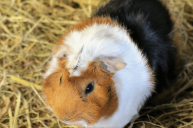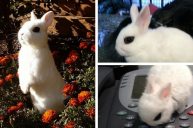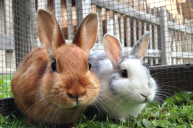This small hamster is a great 'first pocket pet' for teens and adults. The Winter White Hamster is a dwarf hamster and known for the change in the color of its fur during winter. As winter sets in, with shorter daylight hours and snow, the Winter White Hamster transitions its fur from brown to white.
This pocket pet is easy to care for and the most sociable of the hamster species and can provide you with hours of entertainment.
There are so many common names for this little guy including Striped Dwarf Hamster, Djungurian Hamster, Russian Dwarf or Siberian Hamster. Even Hairy-Footed Dwarf Hamsters, because their tails and feet are covered with hair which isn't the case with other hamster species.
Breed overview
Experts at Squeaks and Nibbles says there are two basic types of hamsters, but both are known as 'pocket pets' because of their small size. The better known Syrian, or Golden Hamster reaches up to 7 inches long. In contrast, the Winter White Hamster is about half this size. They're so small!
- They grow to approximately 2-4 inches long and they weigh in at around one to one-and-a-half ounces.
- The Winter White Dwarf Hamster has a rounded shape almost like a tiny furry ball with a tail so short that it all but disappears when they sit down.
- They have furry little feet and a dark stripe running across the top of their body. Their eyes are normally black.
Behavior and temperament
Winter White Hamsters are active, love playing, and need plenty of space. This breed and generally all hamsters love to chew and their housing needs to include exercise wheels, tubes, and toys. Also, they're also awake during the night and most active at dawn and dusk. If you hear a squeak or hiss then your hammie needs some space.
Handle these little guys with care.
Do Winter White Hamsters like to be handled or petted?
Because they are small and quick they can be a challenge to handle, especially for younger children. It all comes down to daily handling from an early age so you can ensure your pet hamster is a social little guy.
Many caution pet owners though that young 'hammies' may want to nibble on your fingers! They only bite when scared so make sure to speak to them before picking them up. Squeaks and Nibbles also explain how to gently pick your hammie up.
"Cup your hands gently around your hamster to pick it up or even let them first climb into a toilet paper roll. Once in your hand, they're tamer and eventually they'll get used to your voice and can be happily picked up and played with."
How do you tame a Winter White Dwarf Hamster?
Of all the hamster species, Winter White Dwarf Hamsters are known to be the most tameable!
What about housing?
The Dwarf Winter White Hamster Guide should be your go-to resource. Housing facts can be found in their guide but here are some highlights:
- Make sure you provide a large enough cage that your pet can't escape from (tips on that later) and feed your hamster a balanced diet with daily freshwater.
- You also need to provide forms of enrichment in hamster toys and exercise wheels.
- Also, provide your hamster with chewy foods and toys to help grind down their teeth - a hamster's teeth never stop growing! (did you know this?)
- You need safe hiding houses for your hammie!
Following the care guide will show you the hamster cage you need, hamster food, hamster care, best cage options, hamster wheels, and food bowl needed when you bring home your new hammie. They make great pets and if we want to be honest, we really like hamsters as first-time pets. The Winter White Hamster may be a better pet than having a few guinea pigs.
This species of hamster is adorable and their furry feet is enough reason to choose this breed over a Syrian Hamster. Some pet stores will have them listed as Djungarian Hamster so be sure to ask the staff to ensure you're talking about the Winter White Hamster!
Have you ever lived with a hamster? Please leave a comment below.
Watch Now: Artists Make Tiny Attractions for Mice




